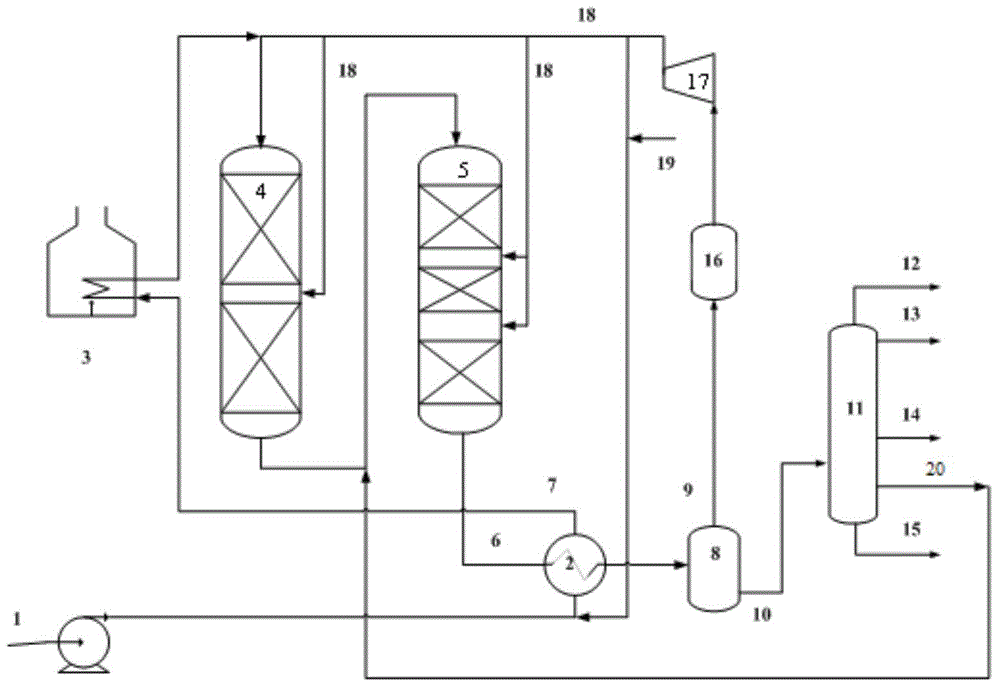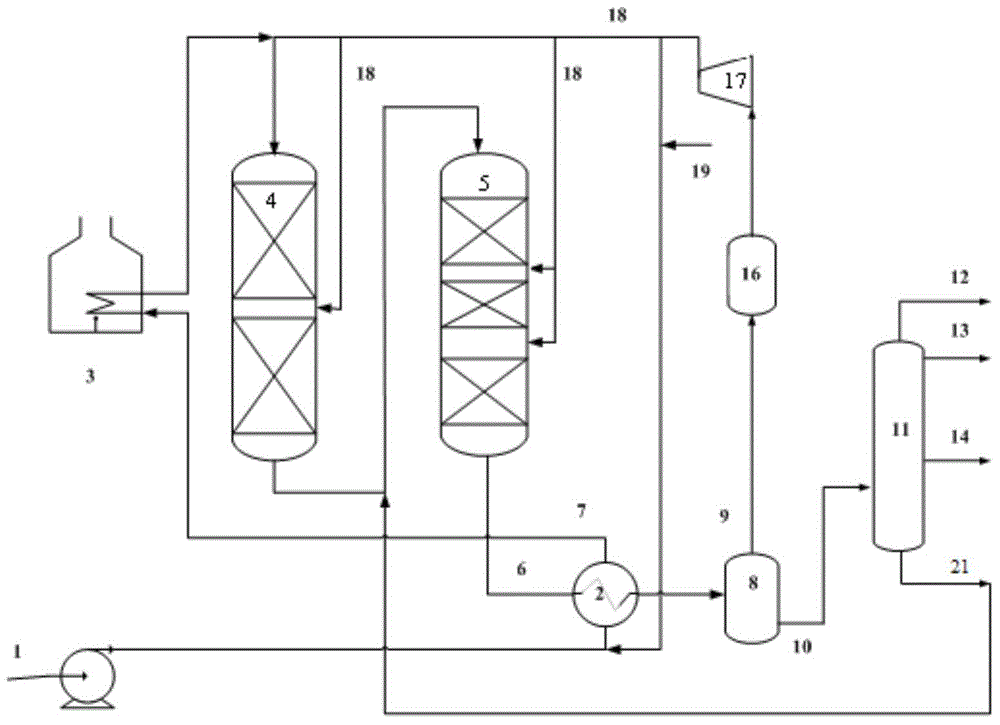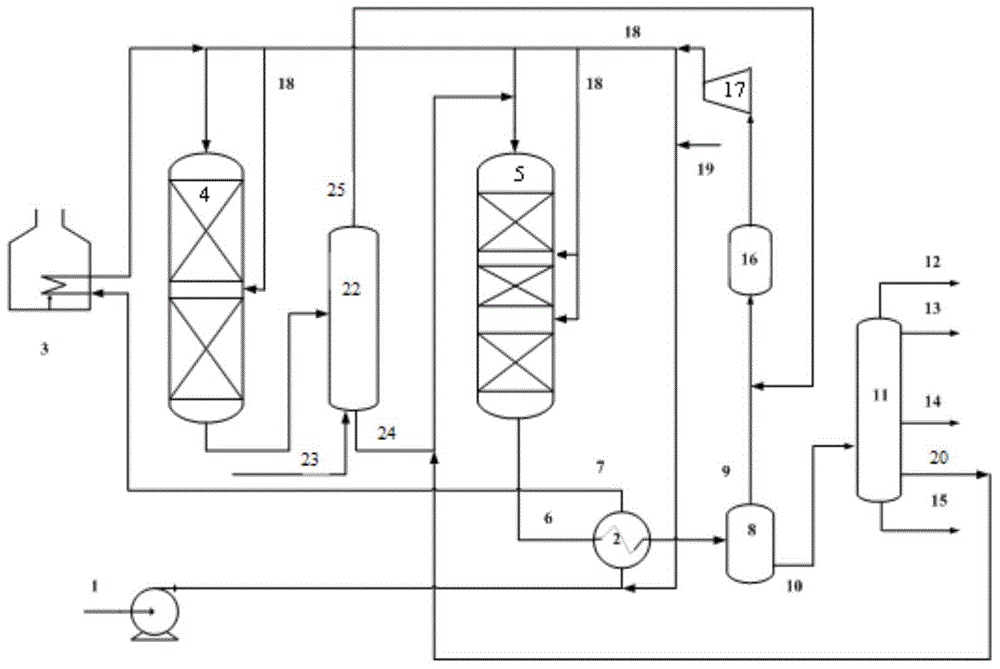Jet fuel production method
A technology for jet fuel and feedstock oil, applied in the petroleum industry, hydrotreating process, processing hydrocarbon oil, etc., can solve problems such as increasing process complexity, achieve low sulfur content and nitrogen content, reduce carbon deposition rate, and economic benefits. low effect
- Summary
- Abstract
- Description
- Claims
- Application Information
AI Technical Summary
Problems solved by technology
Method used
Image
Examples
Embodiment 1
[0108] The feed oil A used in this example is catalytically cracked diesel oil, the properties of which are listed in Table 1.
[0109] This example is carried out in two fixed-bed reactors, and the first fixed-bed reactor is filled with a hydrofining catalyst; based on the flow direction of the liquid material, the second fixed-bed reactor is sequentially filled with a hydrocracking catalyst And replenish the hydrotreating catalyst. The loading volume ratio of hydrofinishing catalyst, hydrocracking catalyst and make-up hydrofinishing catalyst is 40:60:10.
[0110] Both the hydrofinishing catalyst and the make-up hydrofinishing catalyst were prepared as follows.
[0111] With 3000 grams of SilicaGel955 commercial silica gel (U.S. DavisonChemical company product, SiO 2 The content is 99.8% by weight) and 75 grams of scallop powder are evenly mixed, and then mixed with 84 milliliters of nitric acid (concentration 65-68 weight percent, analytically pure, product of Shantou Xilo...
Embodiment 2
[0121] Jet fuel was produced in the same manner as in Example 1, except that the hydrofinishing catalyst used and the make-up hydrofinishing catalyst used were prepared as follows:
[0122] With 200 ml of dilute ammonia solution containing 21.9 g of ammonium paramolybdate (NH 3 The concentration is 10% by weight) to impregnate 200 grams of silica carrier S for 2 hours, then dry at 120° C. for 4 hours, and then bake at 460° C. for 4 hours to obtain a molybdenum-containing carrier loaded with molybdenum oxide. Then, the molybdenum-containing support was impregnated with 156 ml of an aqueous solution containing 13.3 g of cobalt nitrate and 4.4 g of nickel nitrate for 2 hours, followed by drying at 120° C. for 4 hours, and then at 470° C. for 4 hours to obtain the hydrofinishing catalyst. The composition of the catalyst was determined by X-ray fluorescence spectrometry, wherein, MoO 3 The content of NiO is 8.0% by weight, the content of NiO is 0.6% by weight, and the content of C...
Embodiment 3
[0125] Adopt the same method as embodiment 1 to produce jet fuel, the difference is that the hydrocracking catalyst used is prepared by the following method:
[0126] With 185.7 grams of pseudo-boehmite (the product of Changling Branch of China Petrochemical Corporation, the dry basis is 70% by weight) and 93.3 grams of USY zeolite (the product of Changling Branch of China Petrochemical Corporation, the unit cell constant is 24.50 angstroms, crystallinity is 88%, sodium oxide content is 0.8% by weight, and dry basis is 75% by weight) mixed, extruded into a trilobal bar with a circumscribed circle diameter of 1.6 mm, and the wet bar is dried at 120 ° C for 3 hours, then Baking was carried out at 450° C. for 4 hours to obtain a carrier DZ1.
[0127] With 88 ml of ammonium metatungstate (in WO 3 meter, the concentration is 422 g / L), ammonium molybdate (as MoO 3 24.3 g / L) and nickel nitrate (69.8 g / L in terms of NiO) mixed aqueous solution impregnated 100 g of carrier DZ1 for 1 ...
PUM
| Property | Measurement | Unit |
|---|---|---|
| Specific surface area | aaaaa | aaaaa |
| Pore volume | aaaaa | aaaaa |
| Cell constant | aaaaa | aaaaa |
Abstract
Description
Claims
Application Information
 Login to View More
Login to View More - R&D
- Intellectual Property
- Life Sciences
- Materials
- Tech Scout
- Unparalleled Data Quality
- Higher Quality Content
- 60% Fewer Hallucinations
Browse by: Latest US Patents, China's latest patents, Technical Efficacy Thesaurus, Application Domain, Technology Topic, Popular Technical Reports.
© 2025 PatSnap. All rights reserved.Legal|Privacy policy|Modern Slavery Act Transparency Statement|Sitemap|About US| Contact US: help@patsnap.com



